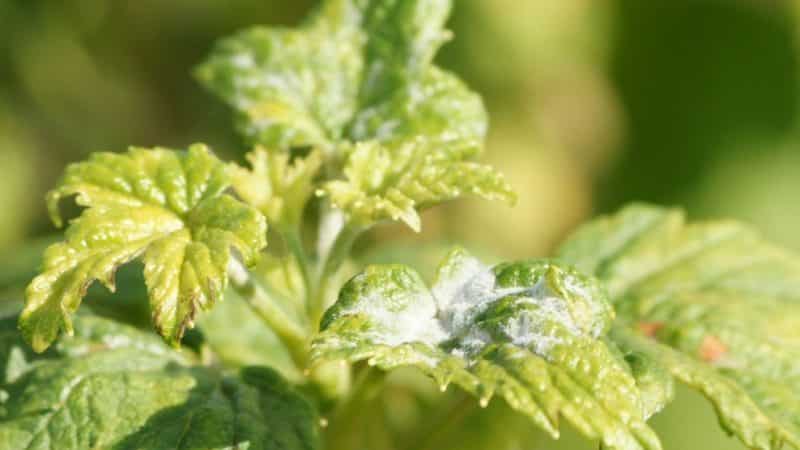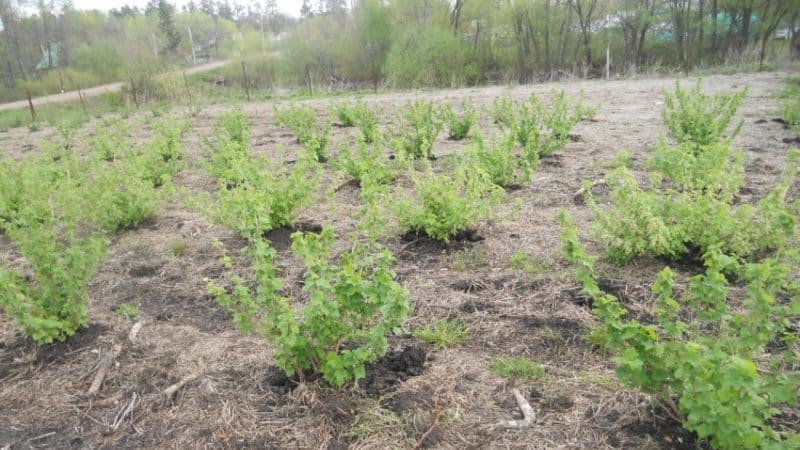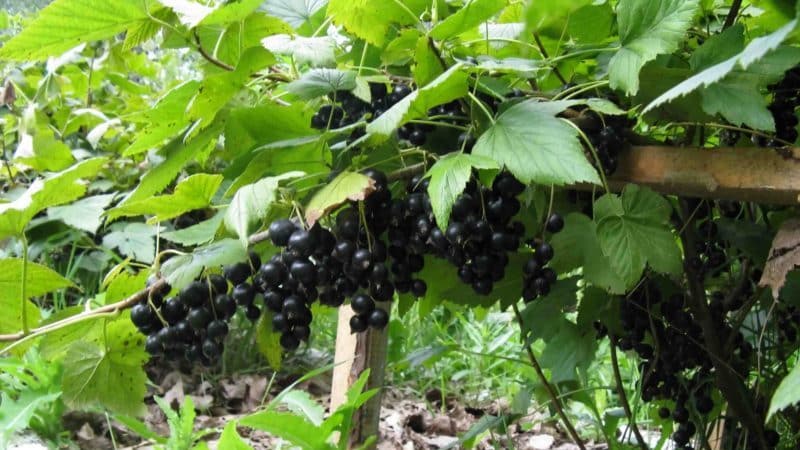The most effective folk remedies for powdery mildew on currants
Currant is one of the most unpretentious fruit and berry bushes. Plant infection is considered one of the few causes of plant death and crop loss. The most common currant disease is powdery mildew.
There are many special preparations for powdery mildew. They are highly effective, but almost always contain chemicals harmful to the health of people and plants. Therefore, many gardeners prefer to solve the problem with the help of folk remedies. Which of them are the most effective - read on.
What is powdery mildew

Powdery mildew is a disease caused by a parasitic form of fungus. The pathogen overwinters in the soil, near the roots of plants. In summer, the fungus becomes active and, under suitable conditions, begins to multiply, affecting the above-ground part of the currant.
The spread of the disease begins in June. Epidemics develop in July or August. It is during this period that special attention should be paid to protecting the garden from fungal infections.
Powdery mildew negatively affects not only the appearance of the plant and the taste of its fruits. The disease leads to crop loss, as the affected berries fall from the bush before they have time to ripen.
Leaves are covered with a dense layer of plaque, which prevents full photosynthesis. Without receiving adequate nutrition, currants stop developing and begin to dry out.
A parasitic fungus reduces the immunity and frost resistance of a shrub; diseased currants may simply not survive the winter.
Note! Powdery mildew most often affects black currants. The red variety is less susceptible to this disease. White currants have the highest resistance to fungus.
Symptoms of the disease

To cope with the disease, it is important to identify it in a timely manner, since most folk recipes are effective only at an early stage of the development of the problem.
The following signs indicate that currants have been affected by powdery mildew:
- Small areas with a white, translucent coating appear on the leaves of affected plants. You can't rub it off the greens with your fingers. The first signs of damage appear on the lower part of the bush, gradually rising to the top.
- The spots on the leaves become denser. The fungus produces tiny droplets of water, causing the leaves to appear damp.
- Currants stop growing. The growth points are gradually destroyed. The bush's resistance to cold weather decreases.
- Over time the leaves fade, wither, curl and dry out. Then they begin to fall off.
- The berries are covered with a whitish coating. Then the light spots turn brown. The fruits do not ripen and fall off.
It is quite possible to notice powdery mildew at an early stage. The disease is easily identified by a light coating on the leaves, which is considered the first sign.
Causes
The main reason for the development of powdery mildew on currants is fungal infection of plants. However, the spores of the pathogen are activated only under certain conditions. They are the ones that provoke infection of shrubs:
- Infected planting material.Fungal spores remain on the seeds and seedlings of infected plants.
- High humidity. The problem occurs with excessive watering, frequent precipitation and stagnation of liquid.
- Sudden temperature changes. This factor becomes especially dangerous at high humidity.
- Incorrectly performed rejuvenation pruning. Currants are often infected during pruning done at the wrong time.
- Excessive application of nitrogenous fertilizers. Nitrogen fertilizers contribute to the development of not only plants, but also fungal infections.
- Lack of sunlight. The causative agent of powdery mildew develops best in the shade. This is facilitated by both an insufficiently lit place on the site and thickened landings. Another reason for too dense plantings is the refusal of sanitary and formative pruning.
- Rare watering. Drought leads to a decrease in currant immunity.
- Violation of root air exchange and fluid stagnation. This is facilitated by too heavy soil or failure to loosen after watering.
- Weeds. They are considered the main breeding ground for infection.
- Insects. Spreads fungal spores.
The causative agent of powdery mildew is the fungus Sphaerotheca morus-uvae Berk. The factors described in the list weaken the plant’s immunity and increase the activity of the fungus, increasing the chances of infection.
Folk remedies for powdery mildew on currants

Folk remedies for powdery mildew on currants are considered the safest. After their use, harmful substances do not accumulate in the berries.
Many preparations for combating powdery mildew are prepared from improvised means that most people have in their kitchen or pantry. The list contains the most effective drugs:
- Onion peel. An infusion is prepared from it.To do this, fill the bucket a third with onion peels, and add boiling water to the rest. The product is infused for 24 hours. The solution is sprayed on currants for prevention or to get rid of the disease at the initial stage of development.
- Ash with soap. Rub a piece of laundry soap into a bucket of boiling water and add a kilogram of ash. The mixture is infused for two days. Treatment with ash solution is carried out every 2 weeks. Before use, the drug must be shaken. The composition is sprayed on plants.
- Tansy. 300 g of dry tansy are poured into a bucket of boiling water. The broth is infused for 24 hours and then boiled for 2 hours over low heat. The mixture is filtered and used for watering currant bushes.
- Soda-soap solution. To prepare it, pour a glass of soda and 1 piece of grated soap into a bucket of water. The solution is sprayed onto the currants immediately after cooling. The procedure is repeated every 7 days.
- Fermented milk mixture. For a 10 liter bucket take 1 liter of whey or kefir and 9 liters of water. The resulting product is sprayed onto the plants every 3 days. The drug forms a film on the plant that limits the access of oxygen to the fungus, causing the latter to die. For the fermented milk mixture to be effective, processing is carried out in dry weather.
- Iodine with milk. 2 liters of milk and 20 drops of iodine are poured into a bucket. The rest of the volume is added with water at room temperature. The drug is used to treat the disease at the initial stage. Currants are sprayed with it once every 7 days.
- Rapeseed oil. Add 10 ml of rapeseed oil to a 10 liter bucket of water. For treatment, shrubs are sprayed with the composition once every 3 days.
- Horsetail. Soak 0.5 kg of chopped horsetail in 5 liters of water for a day.Then the infusion is boiled for 2 hours, filtered, cooled and put in the refrigerator. Spray the plant once a week. Before treating currants, the decoction is diluted with water in a ratio of 1:5.
- Garlic infusion. Garlic arrows are washed and cut into large pieces. They fill the bucket one third full. The rest of the volume is filled with warm water. The mixture is infused for 24 hours. Used to spray diseased bushes every week.
- Mullein. Mullein is mixed with water in a ratio of 1:2. The mixture is infused for 4 days. The resulting concentrate is diluted with water in a ratio of 1:10. Spray the bushes with the product and water the soil around them.
- Potassium permanganate solution. To combat powdery mildew at an early stage of its development, use a weak solution of potassium permanganate. To do this, take 0.5 tsp of the drug per 5 liters of water.
- Dry mustard. Mustard powder is diluted with warm water in a ratio of 1:5. The product is infused for 24 hours. Used for spraying currant bushes.
Advice! Folk remedies are especially effective in the early stages of the disease. Each of the described recipes is also suitable for preventing the disease.
Rules for fighting using traditional methods

For traditional treatment methods to be effective, it is important to know the basic rules for combating powdery mildew. Otherwise, even with a successful solution to the problem, the currant will get sick again:
- Before treatment, plants are inspected for affected areas. All leaves, shoots and fruits with symptoms of powdery mildew are removed. The cut areas are treated with ash.
- The trimmed bush is watered with a hose, trying to wash away the remaining fungal spores. The pressure should be strong enough.
- Next to the diseased plant, as well as near the bushes located next to them, remove the top layer of soil. Instead, soil treated with copper sulfate is poured.
- Plants are treated with an antifungal folk remedy according to the instructions.
- It is advisable to treat not only the infected currants, but also the plants located next to them.
Precautionary measures
Despite the fact that folk recipes for combating powdery mildew are considered the safest, if used incorrectly they will harm the plant.
The list contains basic precautions:
- During processing, put on gloves and a protective mask on your face. Some folk remedies cause irritation to the skin and mucous membranes.
- Before you start treating currants with a new product, apply it to part of the bush. If after 24 hours the condition of the green cover in the sprayed area has not worsened, treat the entire bush.
- Currant processing is carried out early in the morning or in the evening, when the sun is not active. Otherwise, burns will appear on the leaves.
- When preparing the drug, it is important not to violate the concentration specified in the instructions. Elevated concentrations are dangerous for the plant.
- Currants that have been affected by powdery mildew need especially careful care. The first year after recovery it has reduced frost resistance. Therefore, for the winter it is recommended to mulch the bush and protect it with covering material.
Prevention

Powdery mildew is not easy to control. And even if you notice it in the early stages and cope with it, in the first few years after treatment the currant will have reduced immunity and low frost resistance.
To avoid infection with powdery mildew, it is important to follow the rules of prevention:
- Disinfection. A solution of potassium permanganate or copper sulfate is used to treat planting material, soil before planting currants and garden tools.
- Loosening. Loosening the soil after each watering and precipitation destroys the earth crust, which prevents full air exchange and contributes to moisture stagnation.
- Removing weeds. They shade the plantings and spread the infection.
- Mulching. If you cover the soil around currant bushes with rotted straw, hay or sawdust, the growth of weeds will slow down, loosening the soil after watering will not be necessary, and the roots of the plant will be protected from stagnant moisture.
- Drainage. It is poured into the bottom of the hole for planting currants. This layer will prevent moisture stagnation.
- Sanitary pruning. Performed every spring. All dry and damaged branches are removed. If the bush is too overgrown, cut off some of the shoots to open access to the sun.
- Choosing the right place. The area where currants grow should be well lit. It is important that groundwater is not located too close to the surface.
- Preventative treatment. Plants are sprayed in spring, July and autumn with a solution of copper sulfate. It is prepared from 1 tbsp. l copper sulfate and a bucket of water.
- Protection from insects. For this purpose, folk or commercial drugs are used.
- Fertilizer application according to schedule. Nitrogen fertilizers are applied once a season - in the spring. In autumn and summer, preference is given to mineral fertilizers.
- Maintaining a watering schedule. Currants are watered once a week. If the summer is hot and dry, then twice. For irrigation, use settled water at room temperature.
- Selection of varieties with resistance to fungal infections. Hybrids have especially strong immunity to fungal diseases.
Conclusion
Powdery mildew is a fungal disease that affects all parts of the plant. It appears as white spots on leaves, fruits and shoots. The danger of infection is that in plants affected by it, immunity decreases, photosynthesis and frost resistance deteriorate. All these factors lead to the death of the plant.
In the fight against powdery mildew, folk remedies show their best side. They do not contain substances harmful to health and the environment and remain effective in the fight against fungal infections. The main thing is to use them correctly.